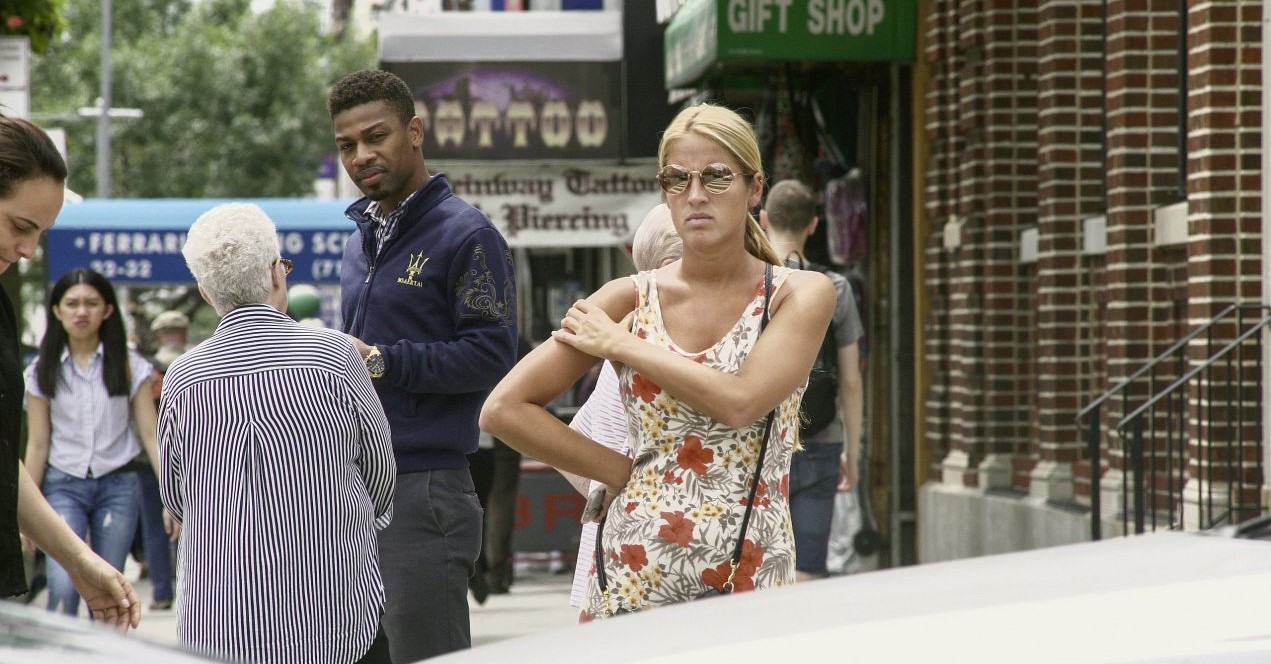Film Text: Intimate Distances
Film Text: Intimate Distances

Intimate Distances
By Caroline Golum
Eavesdropping, idling, or simply people-watching have become a luxury in the age of masked social distancing. My own well-trained ear for juicy conversations has lapsed, robbing me of a favorite pastime I took for granted. In a city as dense and heterogeneous as New York—the setting of Phillip Warnell’s film—every outing used to offer up a Midtown hot bar’s worth of human experience.
These random interactions are often innocuous: someone asking for directions, or a nice place to eat. But after years of pounding the pavement, I’d estimate the ratio of easygoing exchanges and wrenching instances of human suffering is about 1:1. The enduring chasm between these different experiences has centuries-old roots in our city and country’s history. A year of involuntary monasticism has made the encounters that once comprised our daily lives both alluring and anxiety-inducing.
In Intimate Distances, Warnell adopts the grammar of surveillance photography to scrutinize the disparities between haves and have-nots hiding in plain sight. His penchant for unabashed voyeurism immediately stations the audience at a cool remove from the subjects in focus. The style re-creates this lost feature of public life as a kind of “planned happenstance.”
Cinematographer Jarred Alterman captures the banality of feeding parking meters or waiting at crosswalks from a sniper’s vantage point. His ominous technique is made even more so by an accompanying voiceover that adds a sinister air to the ad hoc anthropology on screen. One might mistake the camera’s subjects for quarry in the crosshairs, the sensation evoking both the fear of surveillance and the desire to survey.
A tenuous sense of comfort and security takes hold when Alterman’s roving camera eye lands on casting director Martha Wollner. Blessed with a gift of gab and an eye for interesting characters, she engages men at random with a disarming tone. Her motives are frustratingly opaque; in fact, there is little indication that she has an agenda of any kind. But as she coaxes strangers into a more intimate line of questioning, a different sort of hunt takes shape.
After the requisite pleasantries, she lunges forward with her opening question: “Have you ever felt your life go off the rails, into a totally different direction?” Each man relinquishes a little more backstory than the one who preceded him, divulging their personal histories of financial, mental, and spiritual struggles. Clarity comes in the form of a pair of especially illuminating conversations: one with a Russian immigrant bristling against American prosperity gospel, the other with an aspiring life coach whose hardships interfere with his ability to give advice.
Wollner’s genuine interest gradually begins to dovetail with the voiceover, which emerges as a one-sided interview with a convicted murder as he recounts his time in solitary confinement. Her street subjects are predominantly men of color—a group disproportionately represented in the courtrooms and prisons of the United States. The unavoidable presence of injustice is what ultimately weds these dueling narratives.
Intimate Distances is at its most impactful when delaying any acknowledgement of Wollner’s well-respected work as a talent scout. (She casts extras for both narrative and documentary films.) The slow reveal places the onus on the audience to identify a common thread between these street-level confessions and the pervasive, enraging monologue.
Since its premiere last spring, Warnell’s film has itself become an unintentional artifact of the recent past. One hopes that a greater feeling of amity awaits us on the other side of this indefinite crisis. Will an uptick in empathy affect the way we relate to one another? Watching Martha Wollner’s kindness and patience from a clinical remove doesn’t detach us from her generosity. Instead, her decidedly humanist approach to filmmaking offers a bird’s-eye view of the disparate experiences that make my city whole.
